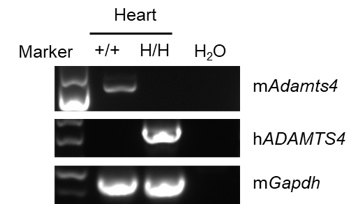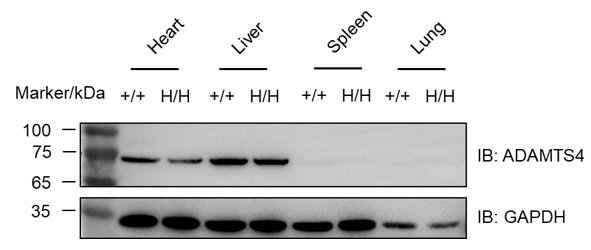B-hADAMTS4 mice
| Strain Name |
C57BL/6-Adamts4tm1(ADAMTS4)Bcgen/Bcgen
|
Common Name | B-hADAMTS4 mice |
| Background | C57BL/6 | Catalog number |
112843 |
|
Related Genes |
ADAMTS-2, ADAMTS-4, ADMP-1 |
||
|
NCBI Gene ID |
9507 |
||
- ADAMTS4 is a member of the ADAMTS family of zinc-dependent proteases, a family of decomposins and metalloproteinases with thrombotic motifs. It can be detected in many tissues of adult body, but mainly concentrated in fat, ovary and brain. The immune cells are mainly expressed in plasma cell-like DC cells. ADAMTS4 is responsible for the degradation of aggrecan and extracellular matrix protein brevican in cartilage. ADAMTS4 expression is up-regulated in arthritis disease and is related to the degradation of aggrecan. Like ADAMTS5, a member of the protein family, ADAMTS5 has a bidirectional regulatory effect in tumors. Adamts4 KO mice are viable and fertile, but have slight signs of impaired coordination. At present, there are 74 drugs in research, mostly small molecule compounds, in the pre-clinical or biological development stage. Drugs are often used to treat arthritis. On the contrary, ADAMTS5, a member of this protein family, has been extensively developed and used in the treatment of osteoarthritis. However, the literature shows that ADAMTS5 plays a dominant role in mice, but ADAMTS4 has a more prominent role in humans. Antibodies against ADAMTS4 are less effective in mice than ADAMTS5, and the reverse may be true in humans.
- mRNA expression analysis: Mouse Adamts4 mRNA was detectable in heart of wild-type C57BL/6 mice. Human ADAMTS4 mRNA was detectable in heart of homozygous B-hADAMTS4 mice.
- Protein expression analysis: ADAMTS4 was detected in heart and liver of both wild-type mice and homozygous B-hADAMTS4 mice, as anti-ADAMTS4 antibody was cross-reactive between human and mouse.
Gene targeting strategy for B-hADAMTS4 mice. The exons 1~9 of mouse Adamts4 gene that encodes 3’UTR region, signal peptide, extracellular domain, cytoplasmic portion and transmembrane domain is replaced by human counterparts in B-hADAMTS4 mice. The promoter and 5’UTR region of the mouse gene are retained. The chimeric ADAMTS4 expression is driven by endogenous mouse Adamts4 promoter, while mouse Adamts4 gene transcription and translation will be disrupted.

Strain specific analysis of ADAMTS4 mRNA expression in wild-type C57BL/6 and B-hADAMTS4 mice by RT-PCR. Heart RNA were isolated from wild-type C57BL/6JNifdc (+/+) and homozygous B-hADAMTS4 mice (H/H), then cDNA libraries were synthesized by reverse transcription, followed by PCR with mouse or human ADAMTS4 primers. Mouse Adamts4 mRNA was only detectable in wild-type mice. Human ADAMTS4 mRNA was exclusively detectable in homozygous B-hADAMTS4 mice but not in wild-type mice.

Western blot analysis of ADAMTS4 protein expression in homozygous B-hADAMTS4 mice. Various tissue lysates were collected from wild-type C57BL/6JNifdc mice (+/+) and homozygous B-hADAMTS4 mice (H/H), and then analyzed by western blot with species-specific anti-ADAMTS4 antibody (Proteintech, 11865-1-AP). 40 μg total proteins were loaded for western blotting analysis. ADAMTS4 was detected in heart and liver of both wild-type mice and homozygous B-hADAMTS4 mice.












 京公网安备:
京公网安备: